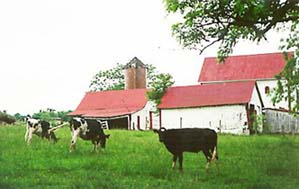

Even though Indiana is a major industrial state, agriculture is also a major component of the economic base of the state. There are over 62,000 farms in the state containing 15.9 million acres. 58 % of all land in Indiana is considered prime farmland. That ranks second to Illinois in percentage of total prime farmland. Agricultural and food systems contribute $16.6 billion in income or 13.3 percent of the state’s economy. Among the top ten exporting industries in Indiana for 1997 the export of food products ranked ninth. Indiana’s number one crop export is soybeans, which makes Indiana the fourth largest soybean exporting state in the nation. Corn, soybeans, hogs and chickens are major agricultural products in Indiana. Other major areas include cattle, dairy, wheat, oats, tobacco, rye, potatoes, tomatoes, melons, peaches, apples, mint and popcorn.
Over the course of the past decade, investment and expansion in certain high-wage industrial sectors have occurred in Indiana, while declining elsewhere. Some products are steel, electric equipment, transportation equipment, chemical products, petroleum and coal products, and machinery. Many industry analysts and economists often refer to Indiana's economy as one that is over-reliant on one or two industrial sectors. However, it should be noted that Indiana's large industrial sector is not characterized by one or two predominant industries, but is notable for its industrial diversity.

Food Services and Drinking Places, Transportation Equipment Manufacturing and Administrative Support Services make up 16.3 percent of the total workforce. The manufacturing sub sectors, outside of Transportation Equipment Manufacturing, are generating only about 60 percent of the employment of the top three sub sectors.
